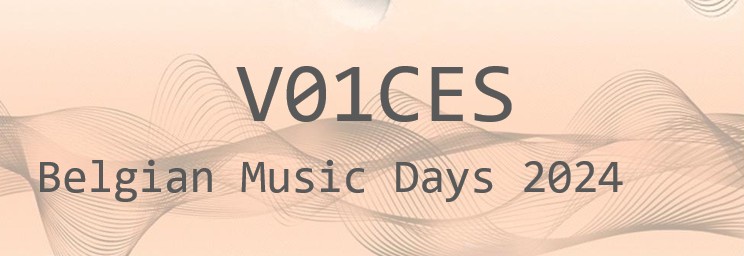An electroacoustic adventure around the human voice
Presented by the Belgian Federation for Electroacoustic Music (FeBeME-BeFEM), which has represented Belgium internationally in this field of music since 1994, notably through its membership with ICEM / IMC – UNESCO.
See also: Belgian Electroacoustic Night | Bozar Brussels et http://www.belgianmusicdays.be/program
The composers and improvisers spatialise their works themselves, unless otherwise stated.
Programme
Tympocaine 200 (Roald Baudoux, Hugues Peeters)
Vox, sans i, sue. ±10′
Free electroacoustic improvisation, multiphonic
This improvisation uses voices from the world memory of fixed sounds. Just as the French programme text uses puns to describe this music, this improvisation will also make words and sounds resonate in surprising ways. When by the end you say to yourself, “I hear voices”, you should know that this is quite normal.
Caroline Profanter
Stimmung (2024, world premiere) 10′
Acousmatic music, quadraphonic
The word Stimmung in German means “tuning” and contains the word “voice”. It also refers to a state of temper, mood or spirit. I used different recordings of human and non-human voices, intentionally and unintentionally captured during field recording trips. They are embedded in the environment, tuned to the atmosphere, in a quotidian temporality, part of a dense texture and traverse different states of consciousness and intelligibility: speaking, shouting, singing.
Joris De Laet
Etude aux inattendus (2012) 8’43
Acousmatic music, octophonic
The composition follows a link between the structure of the sounds and their evolution over time. The trajectories of the chosen sound parameters converge and focus towards a precise end result. They can deviate when sound conglomerates disintegrate into a random state. Compound spatialisation is intended to maintain the transparency of the overall sound spectrum.
Todor Todoroff
Voices Part IV – Hallucinations (2024, world premiere) 10′
Acousmatic music, 12 tracks
In the Voices cycle, Voices Part IV – Hallucinations continues the exploration of the voice, its resonances and transformations. Journeys through intuitions and analogies, disruptions of the senses and phantasmagoria with the words of Arthur Rimbaud, nourished by the vocal explorations of François Vaiana, accompanied by digital processing.
PAUSE
Dirk Veulemans
Hoe mooi is de toekomst? (translation: How beautiful is the future?) (2019, new adaptation 2024) 9’30
2 Pipe organs, video, acoustic music, octophonic
From this project two compositions: In ‘Absolutely Tremendous’, the human voice is rendered acoustically through a self-developed scanning technique by a self-built pipe organ. The voice is thus detached from the person, bringing the drama of the message to the fore. The acousmatic ‘In Paradisum’ is in opposition to the first movement and can be interpreted in various ways.
Charo Calvo
Hüzün (2024, world premiere) 10′
acoustic music, stereo
Laryssa Kim
InCanto (2024, world premiere) 8′
acoustic music, quadraphonic
Spatialisation : Thibault Madeline
In this quadraphonic fantasy, Voce enChante magical formulas, expresses desires, sighs, is bored, expresses wisdom… A ritual, a potion, and then waiting, watching… It’s not always effective, at least not in the way the mind imagines. In the end, however, all’s well that ends well, because “Thy will be done, not mine”.
Leo Kupper
Rezas Populares do Brasil (1998) (parts 1, 3 & 4) 11’57
Acousmatic music, stereo
Spatialisation : Todor Todoroff
Rezas Populares do Brasil is a composition inspired by Brazilian folk traditions and performed by two voices as impressive as they are moving, a mezzo-soprano, Anna Maria Kieffer, and a bass, Eduard Janho-Abumrad. It consists of four movements, from which we hear Meu Anjo, O Ar Vivo and Sabatrana.
Address
Bozar Studio, Palace of Fine Arts, Rue Ravenstein 23, 1000 Brussels
14 February at 9 p.m.

